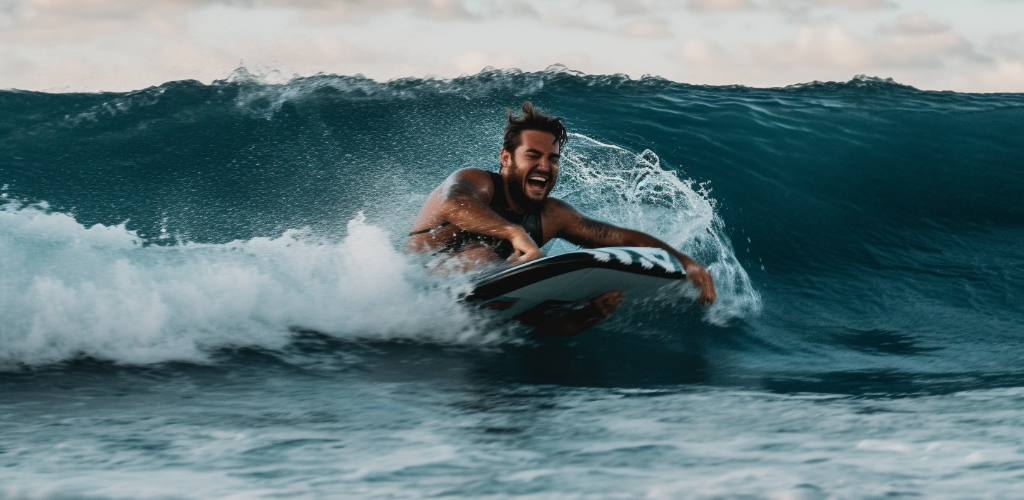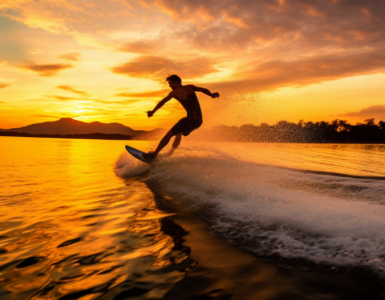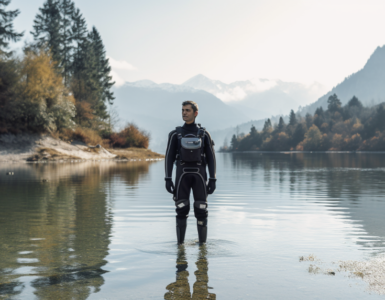Ever heard of boogie boarding? Often referred to as bodyboarding, boogie boarding is an exhilarating water sport that involves riding waves in the ocean on a small, rectangular piece of foam. It’s a thrilling activity that has gained massive popularity worldwide, offering a unique blend of excitement, challenge, and connection with the ocean. If you’ve ever tried surfing, think of boogie boarding as its fun-loving cousin – a bit more accessible, but every bit as adrenaline-pumping.
The History of Boogie Boarding
Boogie boarding has a fascinating history. It was born out of the innovative mind of a man named Tom Morey, a surfer and engineer who first designed the modern bodyboard in 1971. He crafted the first model in his kitchen, using an electric carving knife and a household iron to shape and seal the foam. The sport quickly took off in California and Hawaii before spreading across the world, allowing millions to experience the joy of riding waves.
Over the years, many other key figures have contributed to the development and popularity of boogie boarding, evolving it into the beloved sport it is today.
Equipment Used in Boogie Boarding
Boogie boarding requires some specific equipment to ensure a fun and safe experience. The most important piece, of course, is the boogie board itself. There are different types of boards to choose from, including the prong, drop knee, and bat tail, each offering a unique riding experience.
Another vital piece of equipment is swim fins. These help you paddle out to the waves and provide control while riding. A leash is also essential to keep your board attached to you at all times. Other optional equipment includes wetsuits, rash guards, and helmets, depending on the conditions and your personal preference.
Choosing the right equipment can significantly enhance your boogie boarding experience. It’s always a good idea to do some research or speak with experienced boarders to find the best gear for you.
The Mechanics of Boogie Boarding
Ever wondered how those wave riders manage to glide smoothly over the crashing waves? The secret lies in mastering the mechanics of boogie boarding. It’s all about understanding your body, the board, and, most importantly, the waves. Let’s take a closer look.
Beginners Guide to Boogie Boarding:
Starting with boogie boarding can be an exhilarating experience. Here’s a step-by-step guide to help you get started:
- Positioning: Lay flat on the board with your upper body supported by the top half of the board. Your legs should be hanging off the back end of the board, but not too much – just enough to allow you to kick and propel yourself forward.
- Paddling out: Use your arms in a freestyle swimming movement to paddle out into the sea. Remember to keep your legs kicking for that extra push.
- Catching a wave: Spot an incoming wave, turn your board towards the shore, and start paddling hard. You want to match the speed of the wave to catch it.
- Executing turns and maneuvers: Once you’re riding the wave, you can perform turns by shifting your weight and using your hands to guide the board.
Keep in mind, it’s all about practice. The more time you spend in the water, the better you’ll get at gauging waves and controlling your board.
Common Mistakes and How to Avoid Them:
As with any sport, boogie boarding has its learning curve, and beginners are bound to make a few mistakes. Here are some common ones and how to avoid them:
- Catching the wrong wave: Not every wave is suitable for boogie boarding. Try to identify the ones that break smoothly and offer a good ride. Catching a wave that breaks too soon can lead to a wipeout.
- Incorrect positioning: Your body alignment on the board is crucial. If you’re too far forward, you might nose-dive; too far back, and you lose control. Find the sweet spot where you can maintain balance and control.
- Not using fins: Fins provide extra propulsion and control in the water. Beginners often neglect them, but they are a vital part of your boogie boarding equipment.
Safety Measures during Boogie Boarding
Boogie boarding is a lot of fun, but it’s essential to keep safety in mind. The ocean can be unpredictable, and understanding the risks involved is paramount. Here are some safety measures you should always follow:
- Understand the currents: Rip currents can be dangerous for any ocean-goer. Learn to identify and avoid them.
- Use protective gear: Always use a leash to keep your board close, and consider a helmet and rash guard for protection against impacts and sunburn.
- Don’t exceed your limits: Know your abilities and don’t push yourself too hard, especially when you’re just starting out. The ocean is no place for unnecessary risks.
Remember, the aim is to have fun and enjoy the waves. Stay safe, respect the ocean, and you’ll have a grand time boogie boarding!
Health Benefits of Boogie Boarding
Ever wondered why boogie boarding brings such a rush of joy and excitement? Part of the reason is the myriad of health benefits it provides. Yes, you read that right! Boogie boarding is not just fun, it’s also a great way to keep fit and healthy. Let’s take a closer look, shall we?
First and foremost, boogie boarding is a full-body workout. As you paddle out into the waves, you’re engaging your upper body muscles, particularly your arms and shoulders. And when you’re maneuvering on the board, you’re using your core and leg muscles for balance. It’s like an all-in-one gym session, but far more thrilling!
But the benefits aren’t just physical. Ever felt that sense of calm and tranquility after a session on the waves? That’s not just the after-effect of a good workout. Being out in nature, especially near the ocean, has significant mental health benefits. It helps to reduce stress, improve mood, and even boost creativity. So in essence, boogie boarding is as much a mental workout as it is a physical one.
Boogie Boarding Competitions and Events
Now that you’re aware of the amazing health benefits of boogie boarding, you might be interested in taking your passion to the next level. And what better way to do that than by participating in a boogie boarding competition?
Boogie boarding is a globally recognized sport with competitions held all around the world. These events not only provide a platform for enthusiasts to showcase their skills, but they also bring together a community of people who share a common passion for the sport.
From local beach tournaments to international championships, there are events for every level of boogie boarder. Whether you’re a beginner looking to gain some experience or a seasoned pro aiming for the top, there’s a competition for you.
Interested in checking out or participating in these events? Below is a table listing some of the top boogie boarding events globally along with their location and usual dates.
| Event | Location | Date |
|---|---|---|
| Pipeline Pro | Oahu, Hawaii, USA | February |
| APB World Tour | Various Locations | Throughout the Year |
| Mike Stewart Pipeline Invitational | Oahu, Hawaii, USA | March |
| Itacoatiara Pro | Niteroi, Brazil | June |
| Sintra Portugal Pro | Sintra, Portugal | September |
Top Boogie Boarding Spots Around the World
Ever wondered where the best places to ride the waves with your trusty boogie board are? Well, let’s take a virtual tour around the globe and discover some of the top boogie boarding spots known for their spectacular waves and scenic beauty.
First on our list is the Sunset Beach, located in Hawaii. Known for its powerful waves and crystal-clear waters, it’s a paradise for boogie boarders. Next, we have Banzai Pipeline, also in Hawaii, revered by wave riders for its large, curling waves.
Moving over to Australia, Snapper Rocks in Gold Coast is a must-visit. Its consistent swells and sandy bottoms make it a great spot for boogie boarding. Not to forget El Frontón in the Canary Islands, Spain, a spot famous for its powerful and hollow waves.
And let’s not forget about South Africa’s Jeffreys Bay, renowned for its long, fast, and beautifully shaped waves.
The Future of Boogie Boarding
So, what’s next for boogie boarding? With its popularity continually increasing, we can expect more and more people to be drawn to this exciting sport. Advances in technology are also likely to bring new and improved boogie boards and equipment, making it even more accessible and enjoyable.
Moreover, the sport’s potential for inclusivity is immense. Since it doesn’t require the same level of technical skill as surfing, it’s a fantastic option for people of all ages and abilities. So, can we expect to see more diversity in the boogie boarding community in the future? You bet!
Wrap up
In this blog, we’ve taken a thrilling journey into the world of boogie boarding. We’ve learned about its exciting history, the essential equipment, and techniques, and we’ve even taken a virtual tour of top boogie boarding spots around the world.
Boogie boarding is more than just a sport; it’s a way to connect with nature, a full-body workout, and a means of ultimate thrill and fun. So, why not give it a try? Who knows, you might just find your new favorite hobby!




